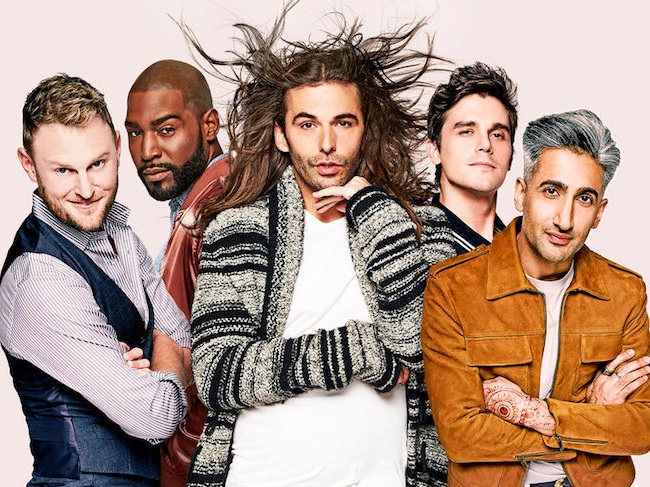The last time I wrote about “Queer Eye for a Straight Guy” had to do with their lone Muslim cast member and what might be his fate were he living in a majority Muslim society.
Since then, the show has become simply “Queer Eye,” a Netflix reboot and a “spiritual” icon for today’s America. Several media have taken up the idea that the gay quintet’s accepting and gracious demeanor is very much like what Jesus might look like if he was here. At the current rate, these guys are going to outdo Oprah in the spiritual force department.
This recent New York Times piece by Amanda Hess piece notes that the show’s makeovers, redecorating and shopping have become the new chic form of expressing repentance and beginning a new life. Born again?
Every episode is the same. Five queer experts in various aesthetic practices conspire to make over some helpless individual. Tan France (fashion) teaches him to tuck the front of his shirt into his pants; Bobby Berk (design) paints his walls black and plants a fiddle-leaf fig; Antoni Porowski (food) shows him how to cut an avocado; Jonathan Van Ness (grooming) shouts personal affirmations while shaping his beard; and Karamo Brown (“culture”) stages some kind of trust-building exercise that doubles as an amateur therapy session. Then, they retreat to a chic loft, pass around celebratory cocktails and watch a video of their subject attempting to maintain his new and superior lifestyle. The makeover squad cries, and if you are human, you cry too.
Van Ness, by the way, with his long brown hair and beard, is a dead ringer for many of the cinematic depictions of Christ over the past 50 years.
The reporter then packs a masterful punch in What It All Means.
Because “Queer Eye” is not just a makeover. As its gurus lead the men (and occasionally, women) in dabbing on eye cream, selecting West Elm furniture, preparing squid-ink risotto and acquiring gym memberships, they are building the metaphorical framework for an internal transformation. Their salves penetrate the skin barrier to soothe loneliness, anxiety, depression, grief, low self-esteem, absentee parenting and hoarding tendencies. The makeover is styled as an almost spiritual conversion. It’s the meaning of life as divined through upgraded consumer choices.
Hess’ article is dripping with spiritual lingo and is a delight to read.
By preaching self-care to the men of Middle America — it has so far plucked its makeover subjects from Georgia, Missouri and Kansas — the show would heal the nation itself through the power of stuff…
The trouble is that when “Queer Eye” offers these comforts, the show implies that its subjects have previously lacked them because of some personal failure. They have been insufficiently confident, skilled, self-aware, dedicated or emotionally vulnerable. The spiritual conversion of the show occurs when the subject pledges a personal commitment to maintaining a new lifestyle going forward.
We don’t critique op-es and editorials, so I began wondering if there were news stories aping the Times by comparing “Queer Eye” to spiritual consumerism. (For a definition of what the latter means, click here).
I was amazed at what I found. Spectrum magazine wrote these folks up with this telling headline: “Queer Eye” and the Divine Gaze: Shame and Grace in 21st Century Worship.”
What can five gay TV personalities teach 21st century Christians about grace? …
I will liken the queer gaze of five gay TV stars (i.e. their unique way of looking at the world and others) to the divine gaze of Jesus. I realize this may seem like a bridge too far for some. But in the spirit of the Good Samaritan, I invite you to consider whether God might be offering us a contemporary parable about grace and its importance to victims of shame — those who have been stripped of their dignity, robbed of their worth, and cast aside on the outskirts of Jerusalem.
That’s quite a theological stretch, there.
At one point, “Queer Eye” actually strays into the religion sphere as Indiewire.com explains:
And as culturally sensitive as the show aims to be, it’s not flawless: One episode makes a poor choice by emphasizing the idea of having a “spirit animal,” a term which, when used by non-Native people, falls into the category of cultural appropriation.
Yes, the “Queer Eye” folks definitely got called on the carpet for that one earlier this year. A religion consultant on the set might have helped.
The National Catholic Reporter goes out on the limb to say the show is “probably the strongest and most vivid representation currently on display in popular culture of how grace works.” NCR illustrates this through the following episode arcs:
• A person is stuck. He or she may simply be in a rut or might be weighed down by something in the past that is preventing flourishing in the here and now. Grace is not there.
• A friend or loved ones nominates this person for the makeover — basically a form of intercession. The intervention of the Fab Five is not earned, but is asked for and freely given.
• When the Fab Five arrives, it is a disorienting whirlwind. Piles of clutter get overturned. Old attachments are pried away, sometimes painfully. Favorite crutches and rationalizations are named for what they are and lovingly, but unmistakably dispelled from the individual’s life. New, life-giving habits move into the opening that is created. It is raw. It is overwhelming. It is gratuitous. It is grace.
• When the week is over and the transformation has occurred, it’s then up to the person to continue cooperating with what they’ve learned from the epiphany, the graced encounter with the five persons in one makeover team. Are things perfect now? No. But the difference is undeniable.
As the New York Times points out, all this transformation takes a boatload of money, which is to say the person who’s been made over simply needs to up their take-home pay and then all will be well. Hence the idea of spiritual consumerism.
NCR suggests that the show has “a Pope Francis feel to it,” but if the real pope were watching it, one would hope he had the discernment to see the show as it really is: A well-meaning attempt to fix the surface problems without changing the mess underneath.
How I wish it were true that merely getting a new wardrobe, hair cut and better living quarters could change the inner wounded child, but most makeovers require someone to stick around to provide added support.
“Queer Eye’s” recipients get no such help. I wish one of their episodes could be re-visits to old haunts just to see if the objects of their charity managed to keep up the momentum on their own.
The Times reporter suspects not. I’d like to see other entertainment reporters take a whack at this idea; if “Queer Eye’s” experiments keep to their course. Does this infusion of “grace” from five gay guys truly stick? What about the need for rigorous inner transformation? Come to think of it, the entertainment writer might want to team up with a religion specialist. If nothing else, the show’s stars wouldn’t be calling on their “spirit animals” for inspiration.











